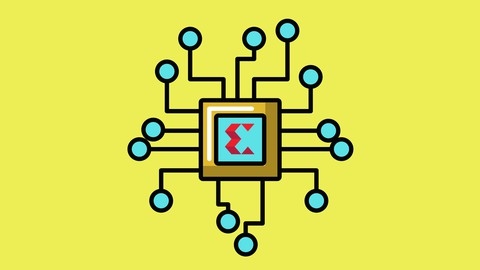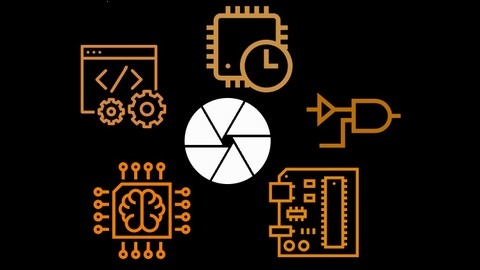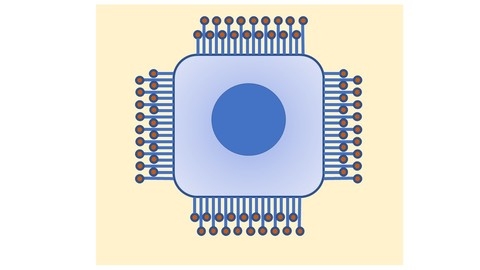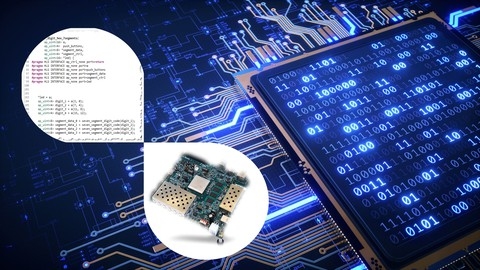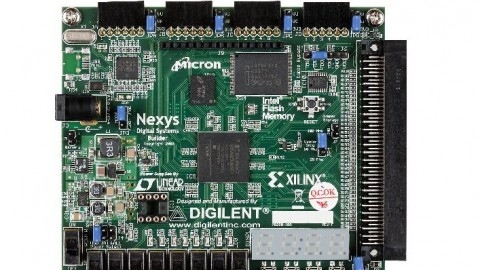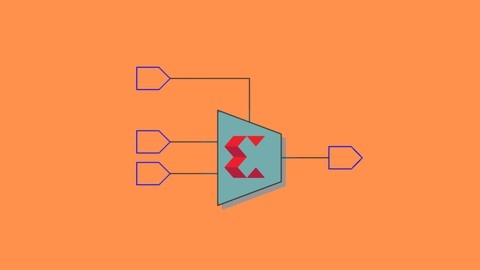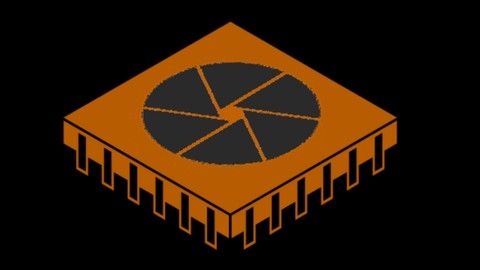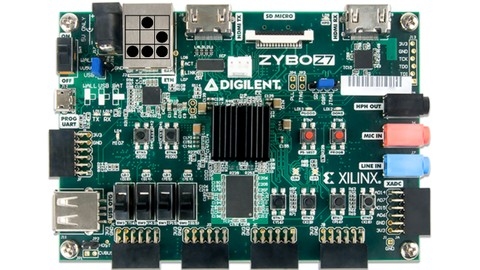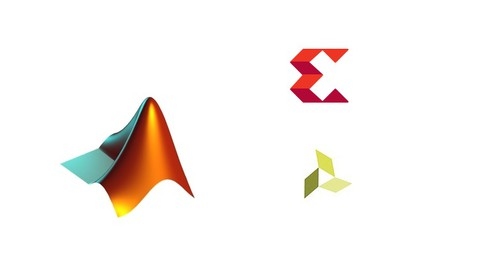Field Programmable Gate Arrays (FPGAs) are powerful reconfigurable integrated circuits that offer unparalleled flexibility and performance for a wide range of applications, from digital signal processing to custom hardware design.
By learning FPGA design, you can unlock a world of possibilities, building complex systems and pushing the boundaries of electronic engineering.
Finding the right FPGA course on Udemy can be a daunting task, with so many options available.
You’re looking for a program that’s comprehensive, engaging, and taught by experts who can guide you through the complexities of FPGA design and the industry-standard tools like Vivado.
You want to learn the fundamentals, but also be prepared to tackle real-world projects and gain practical skills that can be applied to your work.
Based on our in-depth review, Verilog for an FPGA Engineer with Xilinx Vivado Design Suite stands out as the best overall FPGA course on Udemy.
This comprehensive program covers everything from the basics of Verilog to the advanced features of the Vivado design suite, preparing you for a career in FPGA design.
You’ll learn to implement various design methodologies, build complex circuits, and tackle projects that will solidify your understanding.
The course’s hands-on approach, emphasis on debugging, and focus on real-world applications make it an exceptional choice for both beginners and experienced engineers.
While Verilog for an FPGA Engineer with Xilinx Vivado Design Suite is our top pick, there are other great courses on Udemy that might be a better fit for your specific needs.
Whether you prefer VHDL, want to explore specific FPGA architectures, or are looking for a beginner-friendly introduction, we have something for you.
Keep reading for a full list of our recommendations and discover the perfect course to take your FPGA journey to the next level.
Verilog for an FPGA Engineer with Xilinx Vivado Design Suite
This course provides a solid foundation in FPGA design, guiding you from the basics of Verilog to building complex projects using Xilinx Vivado.
You’ll start with the fundamentals of Verilog, covering data types, operators, and different modeling styles.
This comprehensive approach will give you a strong understanding of how to implement various design methodologies, including behavioral, structural, and gate-level modeling.
You’ll then move on to building essential digital circuits like adders, counters, and memory blocks.
The course emphasizes practical application, introducing you to using IP cores from Xilinx to streamline your design process and delving into the crucial world of Finite State Machines (FSMs).
You’ll also explore powerful debugging tools like the Integrated Logic Analyzer (ILA) and Virtual I/O (VIO) to effectively troubleshoot your designs.
The course doesn’t shy away from real-world applications, giving you hands-on experience by working on projects like implementing a UART interface, SPI communication, and PWM control.
Throughout the journey, you’ll learn about different FPGA architectures, including CPLDs and FPGAs, and concepts like LUTs (Look-Up Tables) and the Spartan 6 architecture.
While the course covers a wide range of topics, you might benefit from additional resources for deeper dives into specific areas like advanced Verilog concepts or particular FPGA architectures.
FPGA Embedded Design, Part 1 - Verilog
This course offers a solid introduction to the exciting world of FPGA design, focusing on the powerful Verilog hardware description language.
You’ll embark on a journey from the fundamentals of digital circuits, like logic gates and Boolean algebra, to more complex elements like multiplexers, demultiplexers, and adders.
The course emphasizes practical learning with hands-on projects that solidify your understanding of Verilog coding.
You’ll design a 4-bit adder and a counter, gaining valuable experience with the language’s syntax and structure.
The inclusion of multiple simulation tools like EPWave, GTKWave, and Modelsim ensures you’re equipped to test and refine your designs.
While the primary focus is on Verilog, the course briefly touches upon other hardware description languages like VHDL, broadening your perspective on the field.
This approach provides a balanced foundation, preparing you to explore more advanced FPGA concepts and projects.
This course is a great starting point for those interested in learning the basics of FPGA design.
The comprehensive curriculum, engaging projects, and exploration of different simulation tools will equip you with the essential skills and knowledge to confidently navigate the world of hardware design.
Introduction to VHDL for FPGA and ASIC design
You’ll begin by understanding the fundamentals of VHDL, its purpose, and how to create your first basic design.
One of the course’s strengths is its practical approach to learning.
You’ll explore a variety of VHDL simulators, including Altera Modelsim, Xilinx Vivado Simulator, and GHDL Simulator, offering flexibility in choosing your preferred environment.
You’ll even learn to leverage EDA Playground, a convenient online platform for quick simulations.
The course delves into the core concepts of VHDL, including concurrent and sequential statements, the essential VHDL process, and building hierarchical designs.
You’ll acquire the skills to develop testbenches using tools like Vivado and Modelsim, ensuring your designs meet specifications and function correctly.
Moving beyond the basics, you’ll delve into the world of Register Transfer Level (RTL), the language used to design hardware.
The course covers flip-flops, synchronous design methodologies, and explores different RTL styles.
You’ll also gain a deep understanding of VHDL types, including the crucial “std_logic” type for representing multi-value logic, and learn to work with logic arrays and variables.
The course then guides you through the creation of state machines, essential building blocks of digital systems.
You’ll gain a solid understanding of VHDL operators, including logical, relational operators, math functions, and procedures.
Finally, the course emphasizes verification, teaching you to use testbenches for self-checking, ensuring your designs work as expected with confidence.
This comprehensive course provides a robust foundation in VHDL, equipping you with the knowledge and practical skills needed to design and implement complex digital systems.
Whether you’re a novice or have some prior experience, this course offers a valuable learning experience.
High-Level Synthesis for FPGA, Part 1-Combinational Circuits
This course starts by introducing you to the world of FPGAs, explaining their components like Lookup Tables (LUTs) and Flip-Flops, and highlighting the benefits of using them over traditional CPUs.
The course focuses on mastering Vivado-HLx, the essential tool for designing circuits with high-level synthesis (HLS).
You’ll learn to build basic input/output circuits before moving onto more complex combinational circuits, such as logic gates and adders.
Key concepts like propagation delay and circuit optimization for performance are covered.
The course also introduces techniques like loop unrolling and guides you through creating testbenches using C/C++ to verify your circuits.
One of the strengths of this course is its practical approach.
You’ll work with the Basys3 FPGA development board throughout, putting the concepts you learn into practice.
This hands-on experience is invaluable for solidifying your understanding and gaining the practical skills needed for FPGA design.
You’ll design and implement various circuits, including a traffic light controller, a seven-segment display, and a parity bit generator.
The course concludes with two comprehensive projects: a home alarm system and a simple calculator.
While the course provides a strong foundation in FPGA design, it’s important to note that this is an introductory course.
You’ll gain a solid understanding of combinational circuits and HLS techniques but will need to explore further to delve into more advanced topics like sequential circuits, memory management, and complex system design.
Learn FPGA Design With VHDL (Intel/Altera)
This comprehensive course provides a robust foundation in FPGA design using VHDL, equipping you with the knowledge and skills to create real-world projects.
You’ll start by diving into the fundamentals of FPGAs and the powerful Cyclone IV Development Board, learning to install and utilize Quartus, the industry-standard software for FPGA design.
The course then delves into the building blocks of VHDL, covering data types, operators, and the structure of a VHDL file.
Throughout the course, you’ll engage in a series of practical projects, starting with a simple switch and LED project.
You’ll build a state machine, learn about component instantiation and using Quartus’ IP Wizard to generate a PLL.
You’ll also learn to read and understand Quartus Netlist Viewer and Fitter Reports, crucial for optimizing your designs.
The curriculum covers a wide range of VHDL concepts, including concurrent and sequential statements, signal assignments, and the generation of PWM signals.
You’ll even create a project to control an LED using PWM.
You’ll learn about variables, functions, procedures, packages, libraries, parameterized components, type conversions, and much more.
Essential components such as tri-state drivers, comparators, multiplexers, shift registers, serializers, RAMs, ROMs, and finite state machines are explored in detail.
The course emphasizes good design practices, showcasing how to debounce switch inputs and create a 4-digit counter using a seven-segment display.
You’ll learn the importance of test benches for verifying the functionality of your modules.
The course concludes with a complex project – building a UART (Universal Asynchronous Receiver/Transmitter) communication system.
You’ll delve into the RS232 protocol, design and test a BaudClkGenerator, a serialiser, and the UART transmitter and receiver.
By creating a top-level module that integrates all the modules you’ve designed, you’ll gain hands-on experience with the full implementation process in Quartus.
FPGA Design and VHDL
You’ll start with the fundamentals of VHDL, the language used to program FPGAs, and get hands-on experience with the industry-standard Xilinx design flow.
From downloading and installing the software to navigating its powerful features, you’ll be guided through every step.
You’ll then dive into the core concepts of VHDL, learning about Entities, Architecture, Signals, and the various constructs that bring your designs to life.
These concepts are reinforced through practical lab exercises.
Imagine building circuits using LEDs and switches, controlling their behavior with VHDL code.
You’ll also explore sequential statements, learning to design circuits that react to changes over time, including the use of Processes, Case_Select statements, and Clock Dividers.
This foundation will equip you to build counters, timers, and other complex circuits.
The course takes your FPGA knowledge to the next level by introducing Finite State Machines (FSMs), which are like mini-computers within your FPGA.
These allow you to create complex behavior based on different states.
You’ll put this knowledge into practice by designing a Voting Machine, a real-world application that showcases the power of FSMs.
You’ll be able to simulate this machine in Xilinx, verifying its logic and functionality.
VHDL for an FPGA Engineer with Vivado Design Suite
This comprehensive course equips you with the knowledge and skills to navigate the world of VHDL and FPGAs.
You’ll embark on a journey starting with the fundamentals and progressing to intricate designs, all while gaining proficiency in the industry-standard Vivado design suite.
The course lays a solid foundation by introducing you to the core elements of VHDL, such as signals, variables, and data types.
You’ll then dive into various design methodologies, including dataflow, behavioral, and structural modeling, enabling you to confidently design real-world circuits like adders, counters, and flip-flops.
One of the standout features is the emphasis on testbench design and hardware debugging.
You’ll master the art of creating robust testbenches to validate your designs, while tools like ILA and VIO empower you to effectively debug your hardware.
You’ll also gain insights into the diverse world of FPGA memories, learning how to leverage their strengths in your projects.
The course culminates in hands-on projects, providing you with practical experience.
You’ll tackle challenges like implementing a VGA controller, a 4-bit barrel shifter with rotate logic, and a UART, solidifying your understanding and enhancing your skillset.
This course caters to those seeking a deep dive into the intricacies of VHDL and FPGA design.
FPGA Embedded Design, Part 2 - Basic FPGA Training
You’ll learn the fundamentals of how these powerful chips work, exploring key components like LookUp Tables and Adders from the ground up.
The course effectively breaks down the differences between FPGAs, ASICs, and CPLDs, while also guiding you through the process of programming them.
The hands-on experience with the DE0-CV board is a significant plus.
It provides a practical platform for applying the concepts you learn and gives you a tangible understanding of how FPGAs are implemented in real-world applications.
You’ll be introduced to Quartus Prime, the industry-standard software for FPGA design, and guided through the process of creating, compiling, and programming your own projects.
While the course covers the basics, it also delves into more advanced concepts like RTL, the language used to describe your FPGA designs.
You’ll explore the System Builder tool, which can significantly simplify the creation of complex designs, and learn about JTAG programming, a crucial technique for loading your designs onto the FPGA.
While the course effectively covers the essentials, it might benefit from more in-depth exploration of specific topics, like advanced FPGA architectures or more complex design examples.
However, for beginners seeking a solid foundation in FPGA fundamentals, this course provides a valuable starting point.
Learn VHDL Design using Xilinx Zynq-7000 ARM/FPGA SoC
This comprehensive VHDL course is designed to equip you with the skills needed to design and implement complex digital systems using the Xilinx Zynq-7000 SoC.
You’ll begin by diving into the fundamentals of VHDL, covering concepts like design units, comments, identifiers, and literals.
The course emphasizes hands-on learning, so you’ll immediately start building circuits with the powerful Xilinx software tools – an essential tool for all your projects.
You’ll then explore data types, operators, and composite data types.
This knowledge will be put to the test as you design a circuit on the Xilinx Zybo Z7 board, an ARM/FPGA SoC, and observe the results in real-time.
Next, you’ll delve into the core of VHDL design by mastering concurrent statements, which are the foundation for creating parallel logic in your circuits.
You’ll learn to build circuits that execute multiple tasks simultaneously, enhancing the efficiency and complexity of your designs.
The course then shifts gears to sequential statements, guiding you through the creation of logic that executes instructions in a specific order.
You’ll learn to use key control statements like “wait,” “if,” “for,” and others, enabling you to precisely control the flow of your designs.
To ensure the functionality of your circuits, you’ll be introduced to the art of creating test benches, crucial for verifying the behavior of your digital systems.
The course also covers state machines, a powerful tool for building complex digital systems that can react to and manage various inputs and outputs.
Moving beyond the basics, you’ll explore advanced concepts like subprograms, packages, and components.
These tools are essential for developing reusable code, enabling you to build complex systems with greater efficiency.
The “ColorFSM” and “Life” demos will provide hands-on experience with these concepts.
You’ll also delve into design for synthesis, a crucial aspect of ensuring that your VHDL code can be successfully translated into actual hardware.
The course concludes with a deep dive into additional libraries and advanced techniques like generics and generate statements.
These tools empower you to design even more powerful and versatile circuits.
You’ll put these advanced techniques to practice through the “NewLife” demo, showcasing the real-world applications of these concepts.
FPGA Design with MATLAB & Simulink
You’ll begin by setting up your development environment with MATLAB/Simulink and either VIVADO or ISE, laying the groundwork for your journey into the world of FPGAs.
The focus quickly shifts to the core tools: HDL Coder and System Generator.
You’ll gain a solid understanding of these tools, learning how to generate hardware description language (HDL) code – the language used to program FPGAs – for both basic and complex designs.
The course emphasizes hands-on learning through a series of real-world projects.
You’ll use System Generator to build designs like FFT (Fast Fourier Transform) and to create custom JTAG configurations.
This practical experience is essential for solidifying your understanding and translating theoretical knowledge into tangible applications.
For those seeking to delve deeper, the course explores advanced topics like LMS (Least Mean Squares) filter design and FIR (Finite Impulse Response) filter design.
You’ll also learn to design OFDM (Orthogonal Frequency-Division Multiplexing) transceivers, which are crucial for modern communication systems.
The course concludes by exploring the Zynq platform, a powerful processor system that combines ARM processor cores and FPGA logic.
You’ll learn to interface peripherals like the XADC and Pmod to your designs using System Generator and VIVADO.
The inclusion of bonus lectures on Vitis Model Composer, a tool for accelerating embedded system development using FPGAs, is a valuable addition.
These lectures provide insights into the latest trends and technologies within the FPGA landscape.
You’ll be well-prepared to enter the field of FPGA design and to contribute effectively to projects involving embedded systems, digital signal processing, and custom hardware development.
